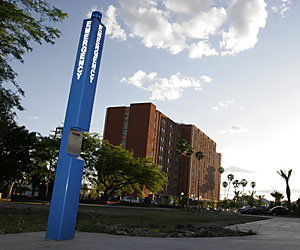 |
|
JOSH FIELDS/Arizona Daily Wildcat
|
Blue lights are used in case of emergency and are designed to be seen from any point on campus. The university continues to install the lights despite any concrete evidence of their effectiveness.
|
|
|
By Jennifer Amsler
Arizona Daily Wildcat
Tuesday, May 3, 2005
Print this
Though emergency blue lights can cost up to $3,000 to install, university officials have no concrete data about how frequent the lights are used each year and if they are worth the cost.
Risk Management and Safety, the Center for Computing and Information Technology and the University of Arizona Police Department representatives said either the data did not exist or it would take a long time to collect.
Sgt. Eugene Mejia, UAPD spokesman, said there are approximately 170 emergency blue lights on campus, and at least one can be seen from nearly any point on campus and are available to anyone who needs police assistance.
If activated, the blue light flashes brightly and sometimes on-duty officers can see it from a distance and promptly respond to the scene, UAPD officials said.
Blue lights trigger police response if a person lifts the telephone receiver or pushes a button, depending on the style.
Even without the statistics about how much the lights assist with reporting a crime, blue lights will continue to be installed in new buildings, said Herb Wagner, the associate director of Risk Management and Safety.
"All new construction projects have at least one that will be put in," Wagner said.
Mejia said though he did not know exact figures, he suspects students would be more likely to use a cell phone rather than finding a blue light to contact police.
"Everyone has cell phones now," Mejia said.
But Luis Puig, UAPD senior program coordinator, said usage of blue lights has "probably remained steady" since they were first installed in 1990.
Puig, who oversees 911 calls, said it is hard to track how often blue lights are used because they are mixed in with calls from cell phones, dormitories and offices on campus.
Dialing 911 from a cell phone might sound like a quicker way to get police response, but Mejia said Tucson Police Department has to transfer the call to UAPD if the emergency is on campus.
With blue lights, a call is placed to UAPD dispatch and an officer immediately responds.
"Sometimes it takes minutes, other times it takes seconds," Mejia said.
Wagner said cell phones might attribute to the possible declined use of the emergency phone that are in parking garages, attached to buildings and on pedestals.
Sarah McKenney, a mechanical engineering sophomore, said she would probably use her cell phone before running and finding a blue light if someone attacked her.
Because of the SafeRide program and other safety resources, McKenney said she does not fear for her safety at night on campus.
"I do walk around at night but I try to avoid it," she said.
McKenney said although she would be more likely to use a cell phone, not everyone has one, making the blue lights a necessity for the future.
However, just because the blue lights are not utilized often does not mean people are not contacting police with emergencies.
"We've seen an increase of students reporting crimes," Mejia said.
The pedestal that stands alone costs between $2,000 and $3,000 to install, depending on the location, Wagner said. The emergency lights attached to buildings costs between $1,800 and $2,400 because they are included in the building's phone wirings.
Wagner said the emergency phones serve primarily as a security device.
"If someone needs to, they can run and report something," he said.
Erin Gleeson, a geology junior, said she is indifferent to the emergency lights when she is on campus at night.
In an emergency, Gleeson would use whatever means of communication she had closest to her to report a crime.
"I use common sense," she said.
